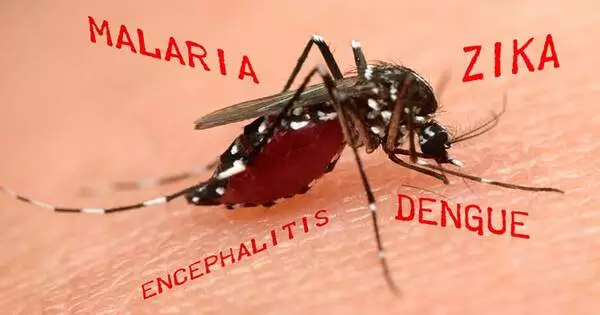If you ask any adult what kind of disease mosquitoes transmit, they will most certainly say malaria fever. While this is correct, the unfortunate fact is that mosquito bites transmit more than malaria because the disease carried by a certain mosquito varies depending on the insect species.
So, what diseases are mosquitos capable of transmitting to their victims? These are the ones…
The West Nile Virus (WNV)
West Nile fever is caused by the West Nile virus, which is spread by mosquitoes. Experts estimate that, as terrible as this fever is, approximately 80% of human infections have few or no symptoms.
Serious disorders can include infection of the brain (encephalitis), spinal cord, and tissues surrounding the brain and spinal cord (meningitis), which can be fatal, experts warn. Most WNV infections are not dangerous, and many people have no symptoms or have moderate flu-like symptoms like headaches, muscle aches, and a high temperature (fever).
If you have some of these symptoms, the best way to be sure of your illness is to see a doctor.
“For most people, it is a very mild infection and isn’t harmful. However, it may be more serious for pregnant women, as there’s evidence that it causes birth defects — particularly, abnormally small heads (microcephaly),”
scientists warn
The Zika virus infection
According to experts, this virus belongs to the virus family Flaviviridae and the genus Flavivirus. Mosquitoes are the primary vectors of the Zika virus illness.
“It is a relatively minor virus that is not hazardous to the majority of people.” It may be more dangerous for pregnant women, however, because there is evidence that it causes birth malformations, specifically abnormally small heads (microcephaly), “scientists warn.
It is carried by Aedes mosquitos, specifically Aedes aegypti and Aedes albopictus.
Experts warn that, as severe as this disease is, most people have no symptoms. If symptoms do appear, they are typically mild and last two to seven days. Rashes, itching all over the body, fever, headache, joint pain (with probable swelling, mostly in the smaller joints of the hands and feet), muscle pain, conjunctivitis (red eyes), lower back pain, and pain behind the eyes are some of the most commonly reported symptoms.
The virus causing St. Louis encephalitis
The SLEV, like others, is spread to humans via the bite of an infected mosquito. Fever, headache, nausea, vomiting, and exhaustion are among the symptoms.
Infected older people may develop encephalitis, which is a brain inflammation that can result in long-term damage or death if not treated promptly by a specialist.

The yellow fever virus
According to Dr. Tunde Owoseni, a general practitioner, “the kind of mosquito that is known to carry the virus that causes yellow fever is called Aedes aegypti.”
He advises that “yellow fever is not to be taken lightly since it can kill if immediate medical attention is not sought.”
According to Owoseni, yellow fever has three stages of infection:
Stage 1 infection: Headache, muscle and joint aches, fever, flushing, loss of appetite, vomiting, and jaundice are all symptoms.
Stage 2 (remission): The fever and other symptoms have subsided.
Stage 3 (intoxication): Many organs, including the heart, liver, and kidney, may have problems.
Dengue fever
Dengue fever is a painful, debilitating mosquito-borne disease caused by any of four closely related dengue viruses, according to experts. These viruses are linked to those that cause West Nile fever and yellow fever.
Dengue fever is spread through the bite of a dengue virus-infected Aedes mosquito.
According to scientists, the Aedes mosquito, like the other disease-transmitting mosquitoes, becomes infected when it bites a person who has the dengue virus in his/her blood; and when such an infected insect bites an otherwise healthy person, s/he also becomes sick.
Dengue fever is thus a person-to-person infection, researchers conclude.
According to Owoseni, dengue symptoms typically appear four to six days after infection and can linger for up to ten days if treatment is not sought.
“The symptoms include abrupt, high fever, terrible headaches, pain behind the eyes, severe joint and muscular pain, exhaustion, nausea, vomiting, skin rash that emerges two to five days after the fever begins, light bleeding (such as nose bleeds, bleeding gums, or easy bruising),” Owoseni notes.
Malaria infection
According to the World Health Organization, malaria is caused by parasites that are transmitted to humans by the bites of infected female mosquitos, such as P. falciparum, which is reported to be the deadliest malaria parasite and the most common in Africa.
“The initial signs of malaria are fever, headache, chills, and vomiting, which are usually present 10 to 15 days after the mosquito bite.”
“P. falciparum malaria can proceed to severe disease and death if not treated promptly,” the WHO advises.
The bottom line is that mosquitoes are murderers. Get rid of mosquitoes in your area by throwing away empty containers that could collect unwanted water for days. In well-ventilated rooms, use mosquito-treated netting and insecticide as needed.
Kill the mosquito before it kills you!





